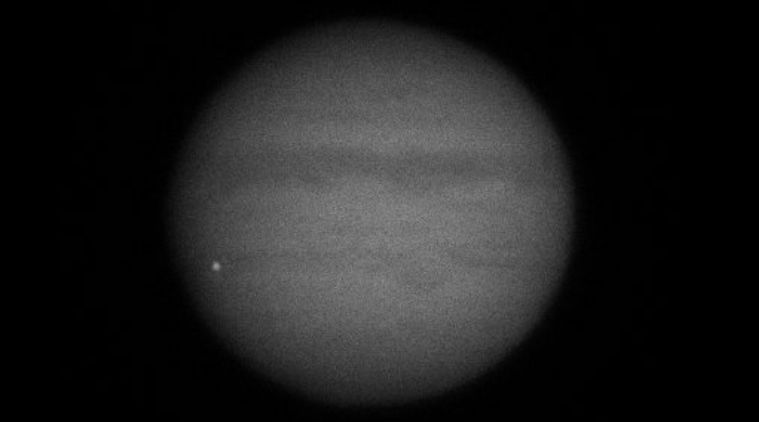 Image of Jupiter taken by Ethan Chappel during impact. (Image source: Twitter / E. Chappel)
Image of Jupiter taken by Ethan Chappel during impact. (Image source: Twitter / E. Chappel)Last month, Ethan Chappel, an amateur astronomer, had photographed the moment when a space rock smashed into Jupiter. The impact was large and was visible from Earth. After more than a month, space scientists have finally unraveled the mystery about the space rock. According to them, the giant planet was hit by an asteroid that was detonated in midair.
On August 7, Chappel had imagined the moment when the space rock crashed into the giant planet. After this, he had shared the image on Twitter. With the help of open source software called DeTeCt, he was able to analyze the flash caused by the explosion.
Single-frame image and DeTeCt output of the potential impact on #Jupiter. pic.twitter.com/kjZZgOYlQf
– Chappel Astro (@ChappelAstro) August 7, 2019
The image had caught the attention of many astronomers, as it was considered a rare moment. Despite the fact that Jupiter is a giant planet that has much higher gravity, it is hit by many asteroids and comets, it is very rare to catch such an event from Earth.
The asteroid was likely to have a size of about 39 feet to 52 feet and a mass of about 450 tons, according to analysis by Ramanakumar Sankar and Csaba Palotai of the Florida Institute of Technology.
Being relatively small, the asteroid did not reach the surface of Jupiter. In fact, it exploded in Jupiter’s upper atmosphere, approximately 80 kilometers above the clouds. Space researchers noted that the blast produced energy equivalent to 240 kilotons of TNT, about half of the meteor blast in Chelyabinsk, Russia, on February 15, 2013.
“Most of these objects hit Jupiter without being observed by observers on Earth. However, we now estimate that 20-60 similar objects impact Jupiter each year. Due to the large size and gravitational field of Jupiter, this impact rate is ten thousand times higher than the impact rate of similar objects on Earth, “said Ricardo Hueso, co-developer of the DeTeCt software, in a statement.
Hueso and his co-developer Marc Delcroix hope that more amateur astronomers will use DeTeCt to analyze video observations of Jupiter and Saturn in order to find and study more of these impacts.
Read also | NASA’s Juno spacecraft shares new image of the lunar eclipse on Jupiter
“The fan community has been galvanized by this event and the number of observers and the volume of data processed is increasing rapidly. DeTeCt is a fantastic showcase for pro-am collaboration, ”Delcroix said.
